For more information contact Robin W. Baird at rwbaird (at) cascadiaresearch.org
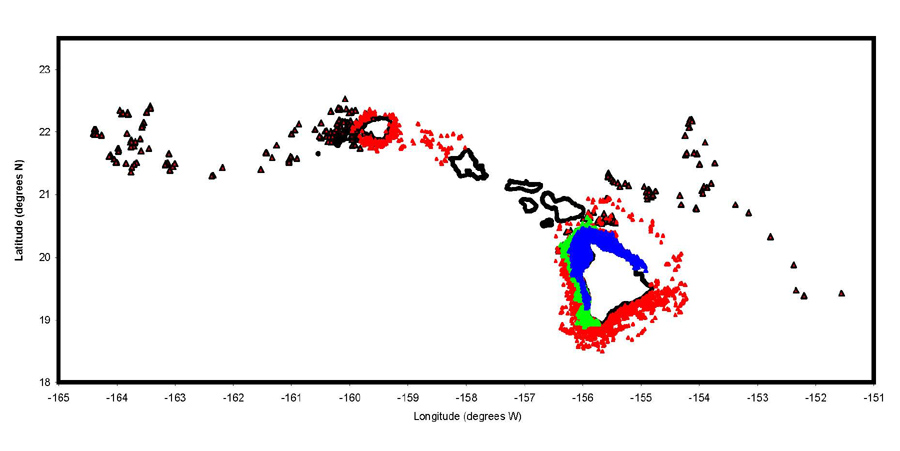
A map showing the satellite locations obtained from 33 satellite tags deployed on four different species of odontocetes during our June/July 2008 field project. As of September 11, 2008 the average duration of transmissions from these tags is 35 days, with a number of tags still transmitting. This field project involved deployment of more satellite tags on a diversity of species of cetaceans over a short period of time than any other study of cetaceans world-wide, providing simultaneous information on the movements of these four species in relation to the main Hawaiian Islands and potentially in relation to naval vessels involved in the RIMPAC ’08 exercise. Short-finned pilot whales – Red, False killer whales – Blue, Blainville’s beaked whales – Green, Melon-headed whales – Red & Black.
Regular updates from the field are below with the most recent updates at the bottom of the page.
From June 25 through July 28, 2008 we will be undertaking research in Hawai‘i, with the first week off the island of Kaua‘i and the last four weeks off the island of Hawai‘i (the “Big Island”). This trip is part of a larger project being funded by NOAA’s Ocean Acoustics Program (National Marine Fisheries Service, Office of Science and Technology), and the U.S. Navy, with one of the primary purposes to examine potential impacts of mid-frequency active sonar on cetaceans during the RIMPAC naval exercise. There are a variety of collaborators on this project, including Woods Hole Oceanographic Institution (WHOI), the Pacific Islands Fisheries Science Center (PIFSC), the Wild Whale Research Foundation, and Duke University. During this period we are also undertaking several side projects with funding and support and/or collaborations with the Northwest Fisheries Science Center, the Pacific Islands Fisheries Science Center, Scripps Institution of Oceanography, the University of Tokyo, Dolphin Quest, Portland State University, and the University of Alaska, Fairbanks. The research team includes Greg Schorr, Annie Douglas and Robin Baird of Cascadia, Dan McSweeney of the Wild Whale Research Foundation, Daniel Webster of Bridger Consulting, Ethan Roth of Scripps, Mai Sakai of the University of Toyko, Darren Roberts of the University of Hawai‘i Hilo, Brad Hanson of the Northwest Fisheries Science Center, and a number of volunteers. Our primary goal for this project is to examine movement patterns of short-finned pilot whales, melon-headed whales, false killer whales, and Cuvier’s and Blainville’s beaked whales (through the deployment of satellite tags) in relation to the RIMPAC naval exercise. For part of the period, researchers from Duke, WHOI, and PIFSC will be simultaneously surveying from the NOAA research vessel Oscar Elton Sette and attempting to deploy suction-cup attached acoustic tags on the same species.
We have a number of additional goals:
- To examine diving behavior and acoustics of a number of species, using suction-cup attached time-depth recorders, acoustic tags, and/or tags with three-dimensional accelerometers.
- To examine the overlap of the offshore and island-associated populations of false killer whales, with surveys offshore of the island of Hawai‘i on a larger charter vessel. This was a project we started on our last trip in April/May. See our updates from that project for more information.
- Recovery of the HARP (High-frequency Acoustic Recording Package) we deployed in April this year, and re-deployment after downloading the acoustic data and replacing the batteries. This instrument is used to acoustically monitor cetacean presence off the west side of the island. In addition we’ll continue to survey in the area of the HARP to compare sightings of different species to acoustic detections. This is a collaborative effort with Erin Oleson at Scripps.
- Collection of skin/blubber samples from biopsies and from suction-cups for examination of stock structure (in collaboration with Susan Chivers and Karen Martien of the Southwest Fisheries Science Center, and Sarah Courbis of Portland State University) and trophic ecology (in collaboration with Jason Turner of the University of Hawai‘i, Hilo)
- Collection of microbial samples from the exhaled breath of pilot whales and other species (in collaboration with Andrea Bogomolni at Woods Hole Oceanographic Institution)
- Collection of fecal samples to examine diet (a collaborative project with Mike Ford of the Northwest Fisheries Science Center, Seattle)
- Photo-identification of 10 species of odontocetes to examine residency/movements
- Collection of survey and sighting data for examination of habitat use
- Collecting dead cephalopods for trophic ecology studies
This will be our first trip back to Kaua‘i since November of 2005, and only the second time we’ve surveyed off the island of Hawai‘i in July.
June 25 update

Rough-toothed dolphin off Ni‘ihau, June 25, 2008. Photo by Annie Douglas.
Our first day on the water for this trip. In our previous surveys off Kaua‘i and Ni‘ihau (2003 and 2005) we covered ~4,600 km of survey trackline in 301 hours of effort. During those efforts rough-toothed dolphins were encountered frequently, but we had seen melon-headed whales only once (in 2003). Not surprisingly, our first sighting of the day was a small group of rough-toothed dolphins, and we were able to get ID photos of all the individuals present. Our second sighting of the day was a group of ~220 melon-headed whales in the channel between Kaua‘i and Ni‘ihau! We were able to deploy satellite tags on two individuals in this group, and also took >2,000 photos for individual identification, to compare back to our photo-identification catalog for this species. Melon-headed whales are a high priority species for satellite tagging, given the near-stranding event in Hanalei Bay associated with the RIMPAC naval exercise in 2004. We are hoping the tags continue to transmit for a number of weeks to allow us to assess movements of this group to the upcoming RIMPAC exercise.
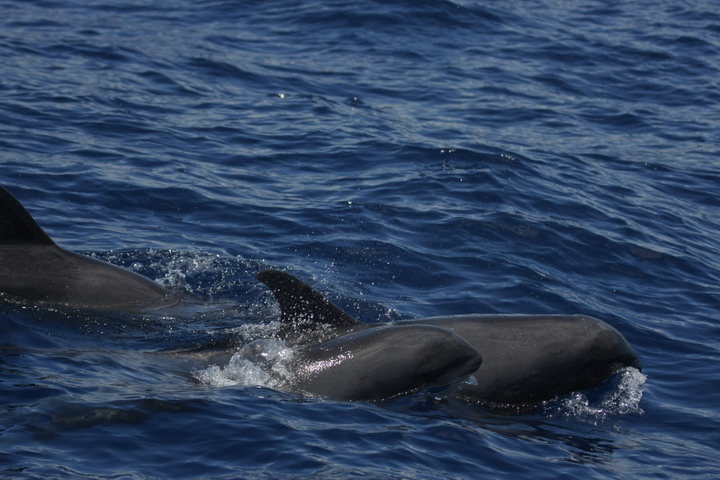
Melon-headed whales off Ni‘ihau, June 25, 2008. Photo by Annie Douglas.
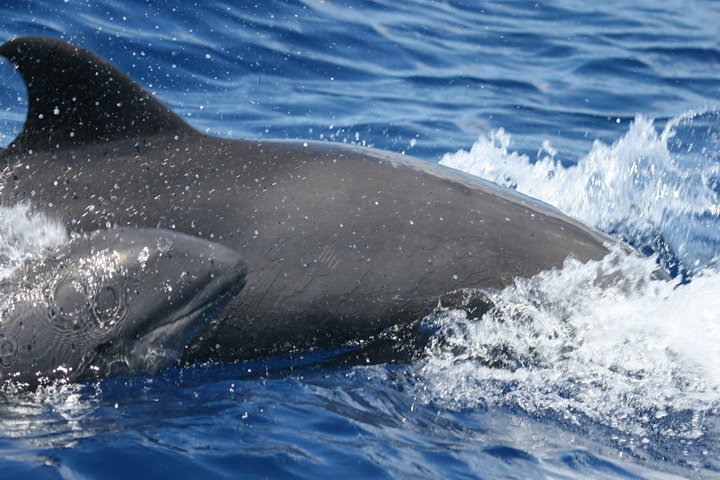
Melon-headed whales off Ni‘ihau, June 25, 2008. Photo by Darren Roberts.
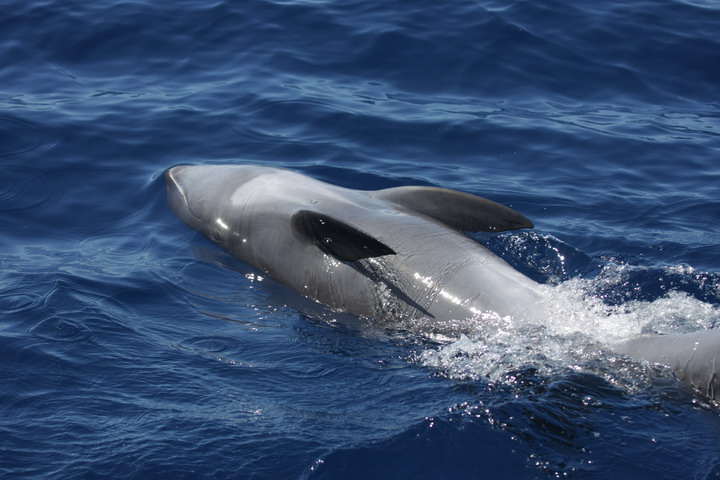
Melon-headed whale off Ni‘ihau, June 25, 2008. Photo by Annie Douglas.
June 27 update
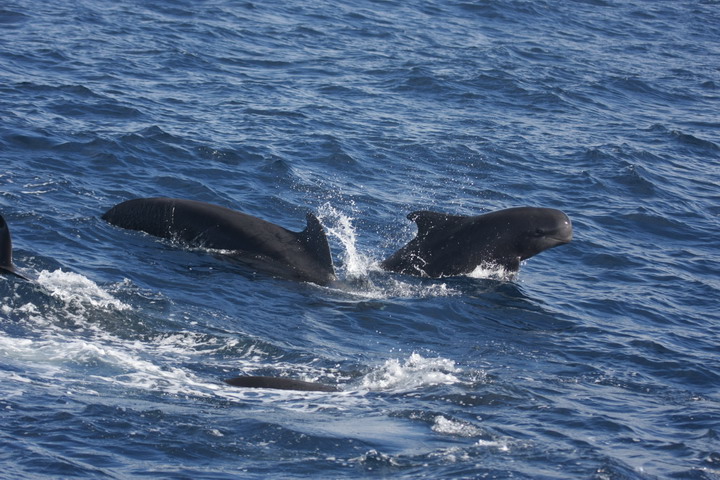
Short-finned pilot whales off Kaua‘i, June 26, 2008. Photo by Annie Douglas
Yesterday (our second day) we encountered another high priority species for this trip, short-finned pilot whales. While we were able to photo-identify all the individuals in the group (~23), sea conditions were not optimal for tagging and we were not able to deploy any satellite tags. We had our second encounter with rough-toothed dolphins (mixed in with the pilot whales) and were able to photo-identify a few additional individuals.
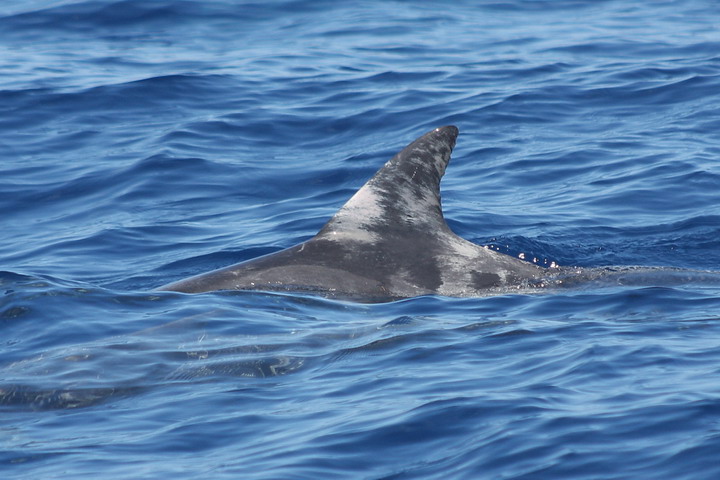
A piebald rough-toothed dolphin mid-channel between Kaua‘i and Ni‘ihau, June 27, 2008. Photo by Robin Baird.
Today we had two very good encounters with rough-toothed dolphins, photo-identifying all 12 in the first group and all 8 in the second group. Rough-toothed dolphins off Kaua‘i and Ni‘ihau are extremely easy to work with compared to those off the big island, with individuals frequently bowriding, and showing no avoidance of the research vessel, unlike those off the big island.
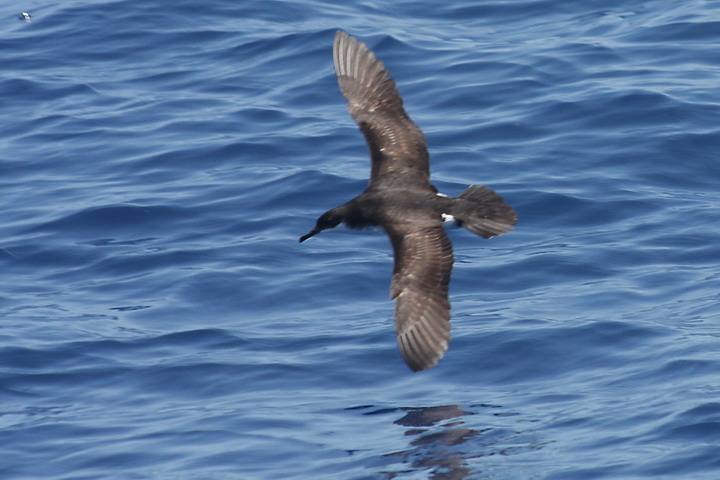
Newell’s shearwater mid-channel between Kaua‘i and Ni‘ihau, June 27, 2008. Photo by Daniel Webster.
Greater numbers of sea birds are also found off Kaua‘i compared to the big island, perhaps due to the lack of introduced mongoose on Kaua‘i allowing more species to breed. In the last three days we’ve had sightings of just two Hawaiian petrels, but numerous Newell’s shearwaters (a species we rarely see off the big island), wedge-tailed shearwaters, red-footed boobies, brown boobies, storm petrels (both Leach’s and possibly band-rumped), Bulwer’s petrels, greater frigatebirds, white-tailed and red-tailed tropicbirds, and a single gull (probably a Franklin’s gull).
June 30 update
The last few days have been dominated by sightings of small groups of rough-toothed dolphins (7 groups in the last 3 days!). Eleven of the 17 encounters we’ve had off Kaua‘i have been this species, an amazing number of sightings of a typically uncommon species. Besides the rough-toothed dolphins, yesterday (June 29) we encountered a group of ~300 melon-headed whales between Kaua‘i and Ni‘ihau. With so many individuals spotting the individuals we satellite tagged a few days ago would have been difficult, to say the least. When we returned to shore we were able to check the ARGOS satellite web site and determined that this was a different group of melon-headed whales (the group we had satellite tagged on June 25 was approximately 60 km NW of Ni‘ihau at the same time we encountered this new group). We were able to deploy a satellite tag on one individual in this new group, so are now receiving locations from two groups of melon-headed whales in the area.
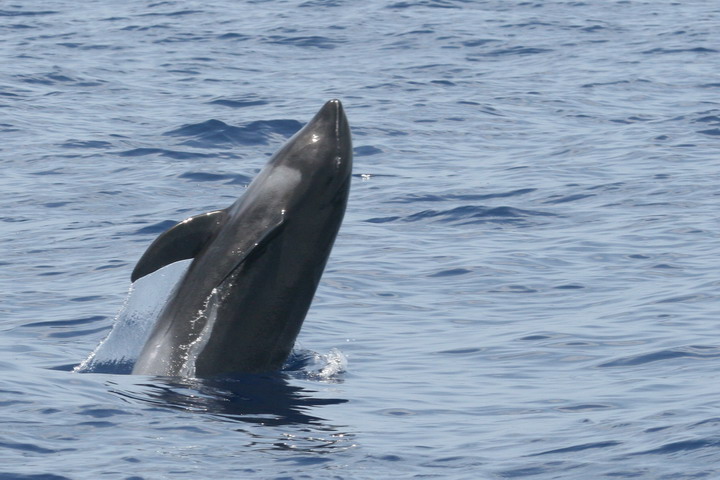
Melon-headed whale breaching, June 29, 2008. Photo by Darren Roberts.
The sea conditions the last two days have been excellent (primarily Beaufort 1 and 2), allowing us to search far to the east and in deeper waters south of the channel between Kaua‘i and Ni‘ihau. As well as several groups of rough-toothed dolphins, today we re-encountered the same group of melon-headed whales that we saw yesterday, and were able to get good photos of the individual we tagged yesterday. Tommorrow will be our last day working off Kaua‘i and Ni‘ihau before heading to the big island, so we are hoping for another calm day.
July 2 update
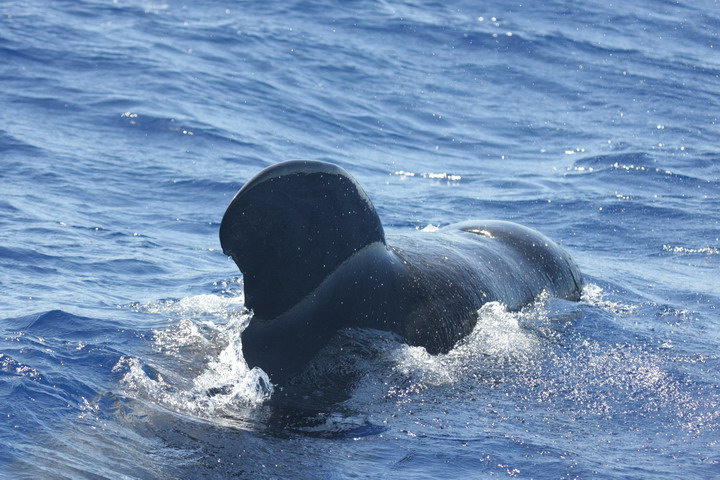
Very large adult male pilot whale off Kaua‘i, July 1, 2008. Photo by Annie Douglas.
Our last day off Kaua‘i was quite productive – we encountered our second group of pilot whales off Kaua‘i, and were able to deploy a satellite tag on an adult female. We had hoped to deploy a second tag on the group, but sea conditions quickly deteriorated and we lost the group in Beaufort 6 seas! All together we covered 819 km of trackline in our 7 days on the water, with 19 sightings of 4 species.
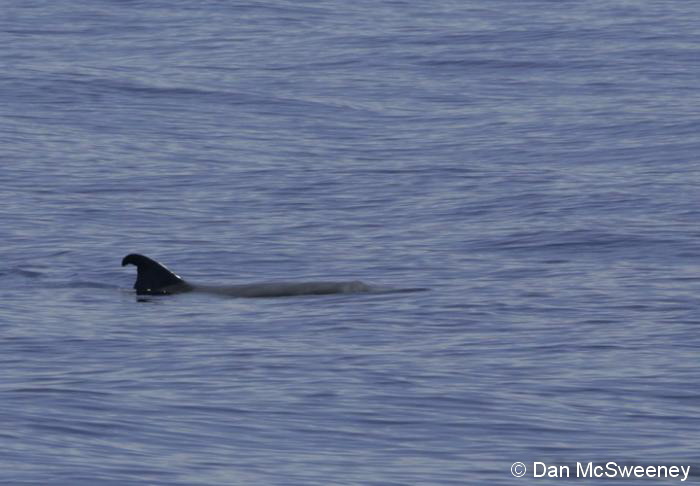
Dwarf sperm whale off the big island, July 2, 2008. Photo by Dan McSweeney.
On July 2nd the Kaua‘i team flew over to the big island while others already on the big island went out for our first day there. Another productive day, with sightings of four species including our first dwarf sperm whale of the trip, a very well-marked individual. Amazingly enough we had another encounter with melon-headed whales. Prior to this trip our long-term average was one group of melon-headed whales every 16 days on the water (based on 413 days of effort!), so having four encounters (with three different groups) in our first 8 days on the water is quite surprising. Besides obtaining about 700 photos for identification purposes, we were also able to deploy two satellite tags on this group, bringing to three the number of groups of melon-headed whales we currently have satellite tags on. Needless to say this has been a good first week for the project!
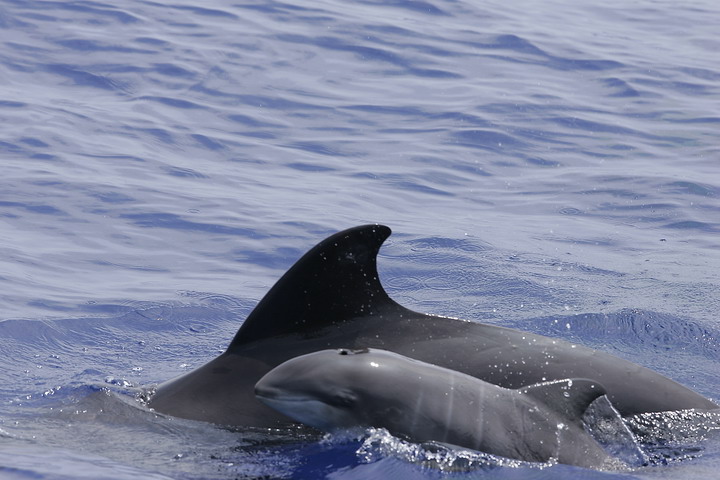
Melon-headed whale female with neonate off the big island, July 2, 2008. Photo by Dan McSweeney. Note the “neonatal folds” (the vertical lines) along the side of the infant, indicating it was probably born very recently.
July 5 update
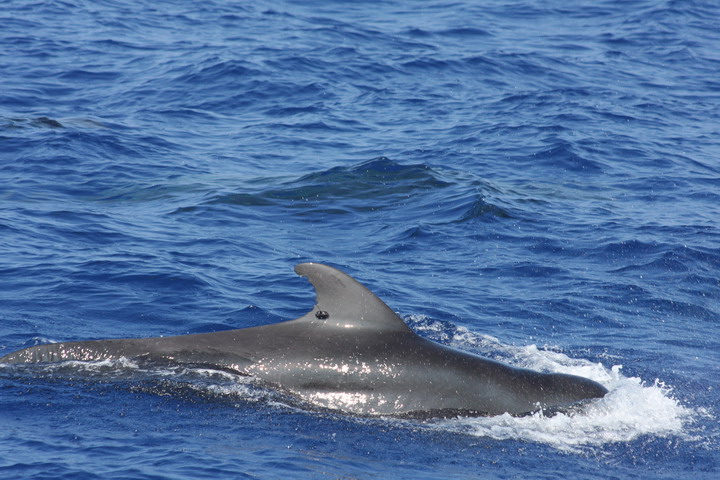
Pilot whale with satellite tag off the big island, July 5, 2008. Photo by Robin Baird.
The last three days we’ve had sightings of six groups of pilot whales off Kona, and have deployed satellite tags on individuals in five of them. We’ve also been getting locations from the last satellite tag we deployed on a pilot whale on our April/May trip (yesterday was day 52), so are obtaining information on the movements of six different groups of pilot whales around the big island. We’ve also had several sightings of spinner dolphins, another dwarf sperm whale, and two sightings of bottlenose dolphins, our first bottlenose dolphins of the trip.
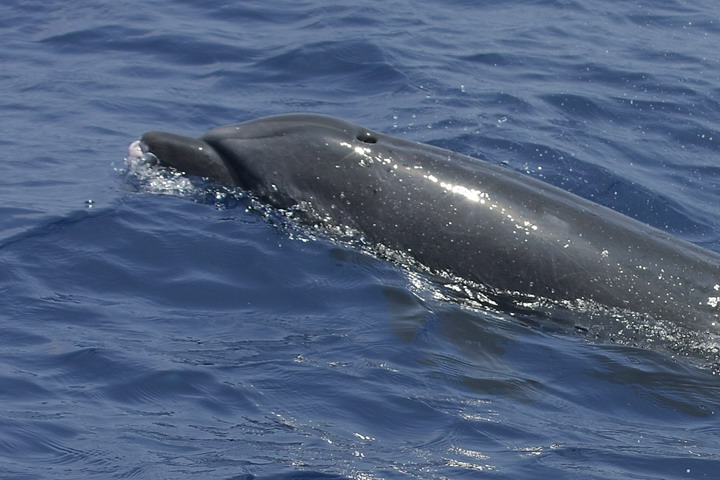
Bottlenose dolphin off the big island, July 5, 2008. Photo by Annie Douglas.
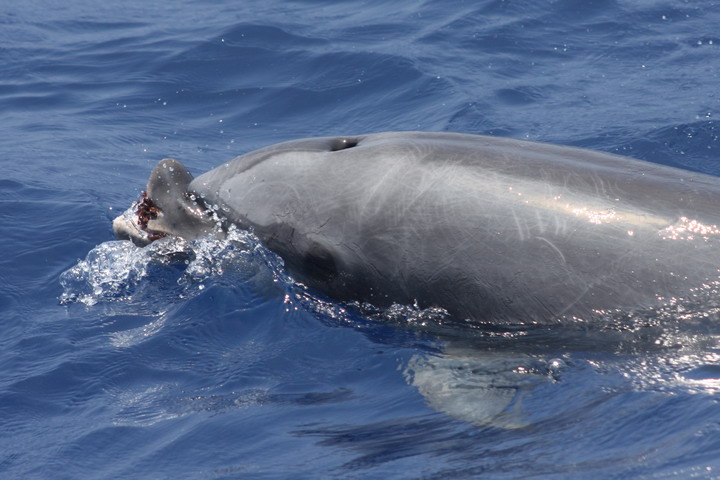
Bottlenose dolphin off the big island, July 5, 2008, with a deformed upper jaw. The upper jaw of this individual bends strongly to the right. The reddish-brown visible on the lower jaw are stalked barnacles, probably growing attached to the exposed teeth on the lower jaw, similar to the stalked barnacles that grow on the exposed teeth of beaked whales in Hawai‘i. Photo by Robin Baird.
July 7 update
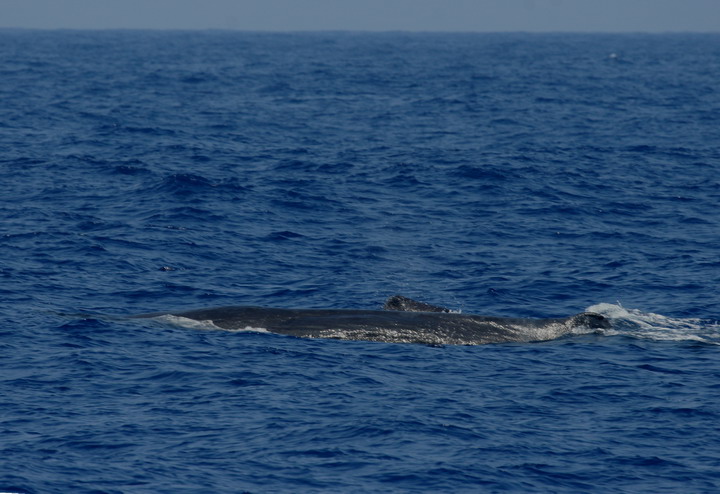
Sperm whale female and calf offshore the big island, July 6, 2008. Photo by Darren Roberts.
On July 6th we headed offshore approximately 70 km west of the big island. We sighted our eighth species for the trip, a group of sperm whales (with several female/calf pairs) on Indianapolis Seamount. Unfortunately none were fluking so we were unable to get individual ID photos.
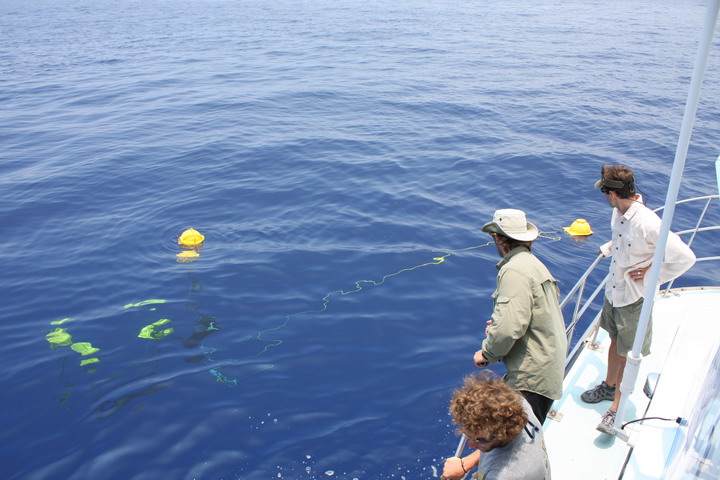
Recovery of the High-frequency Acoustic Recording Package (HARP) off the big island, July 4, 2008. Photo by Robin Baird. After recovery of the HARP on July 4, Ethan Roth from Scripps downloaded all the acoustic data recorded over the last two months, and on July 7 we redeployed the HARP in the same location (in ~650 m depth), an area with frequent encounters of a variety of species of odontocetes. This system is set to record for five minutes out of every fifteen minutes for the next five months, and we plan on recovering it and re-deploying it again on our next trip in November/December.
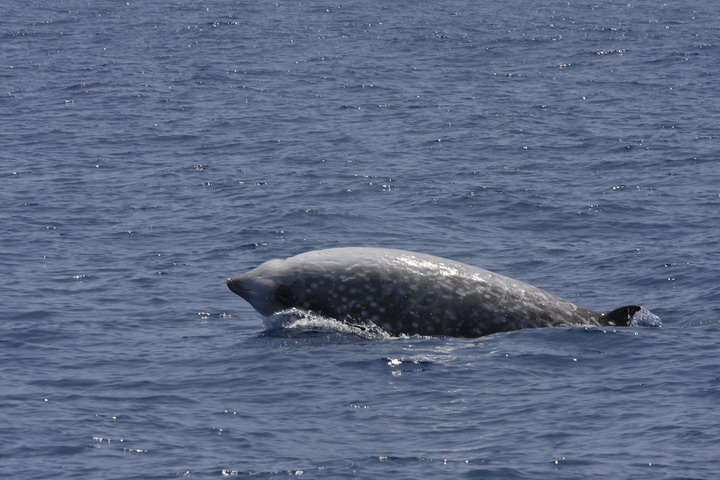
Adult male Cuvier’s beaked whale high-speed surfacing, July 7, 2008. Photo by Darren Roberts. Our ninth species seen in the last six days (and for the trip). We observed a group of four Cuvier’s beaked whales, including an adult male (pictured above), two adult females, and neonate, with slight fetal folds visible in photographs. We were able to get identification photos of all the individuals, and had one tagging attempt, but it was unsuccessful. Cuvier’s beaked whales are often very difficult to approach, and are difficult to track due to their long dive durations (up to ~90 minutes); we re-located the group after a 24-minute long-dive, and waited 60 minutes afterwards but did not re-sight them again.
July 8 update
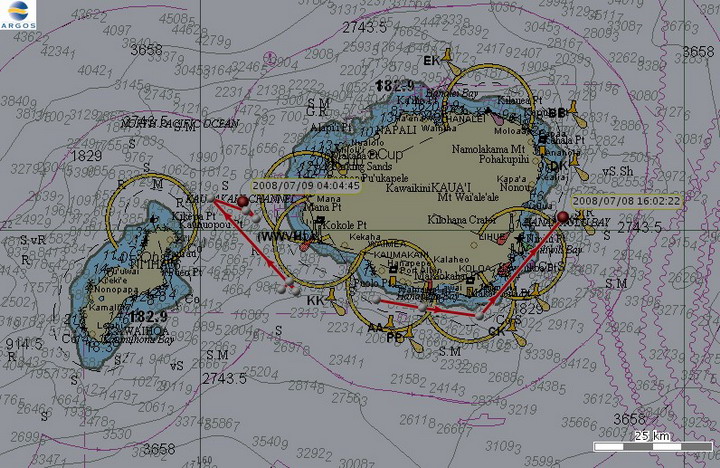
Map showing high quality (LC3, LC2) satellite locations of a melon-headed whale (to the west of Kauai) tagged off Kaua‘i on June 29, and a short-finned pilot whale (to the east of Kaua‘i) tagged off Kaua‘i on July 1, over a 24 hour period. Times indicated associated with the most recent locations are in GMT, not HST.
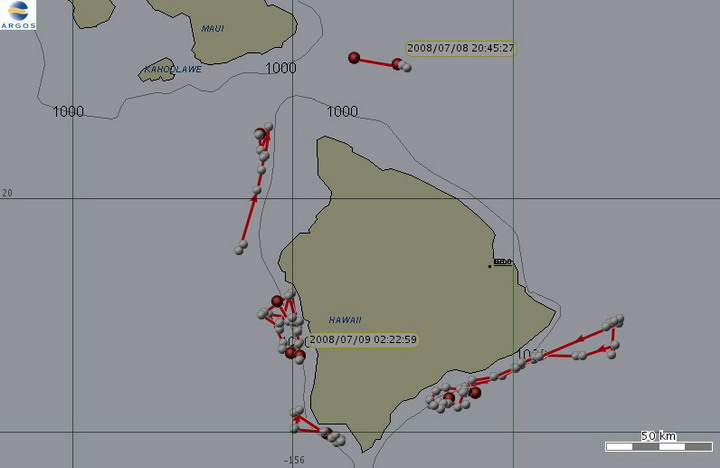
Map showing high quality (LC3, LC2) satellite locations of a number of tagged individuals off the big island over a 24 hour period on July 8. The two northern-most locations are of melon-headed whales tagged off Kona on July 2, while the other locations are of 9 different short-finned pilot whales (from five different groups) tagged off Kona between July 3rd and 5th.
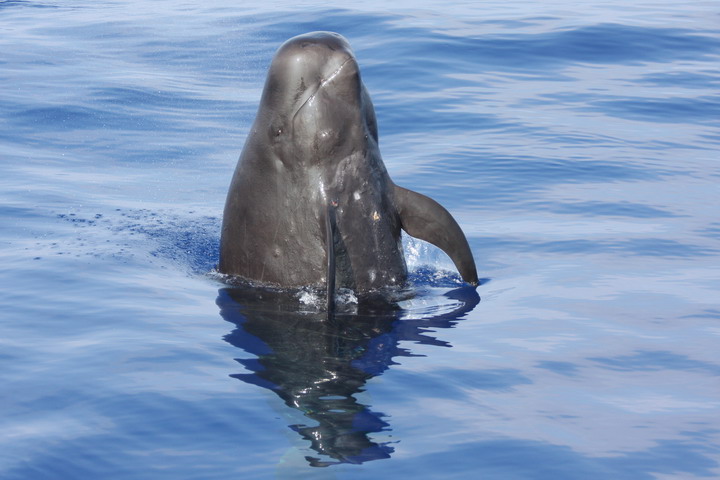
Short-finned pilot whale spyhopping, July 8, 2008. Photo by Daniel Webster. On July 8 we encountered four groups of short-finned pilot whales off Kona, and deployed another satellite tag on one individual, bringing to 10 the number of pilot whales tagged off the big island so far this trip.
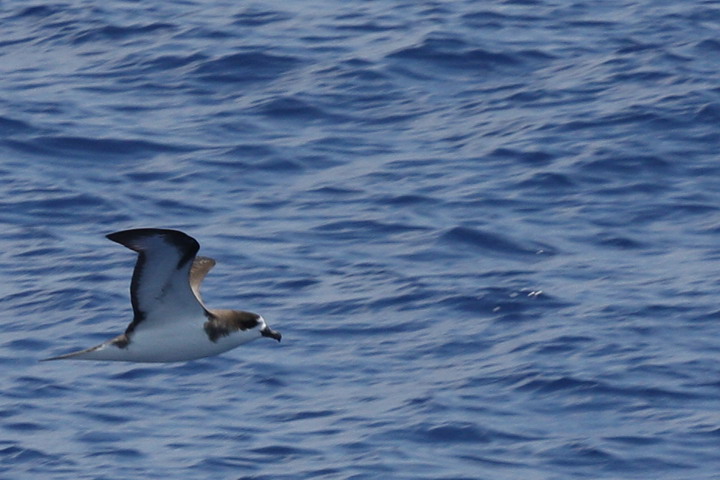
Hawaiian petrel, July 8, 2008. Photo by Daniel Webster.
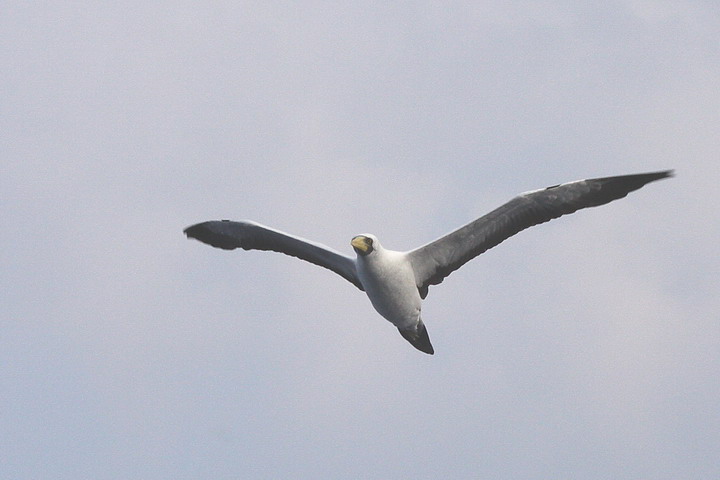
Masked booby, July 8, 2008. Photo by Daniel Webster.
July 9 update
July 9th we headed offshore to survey waters out to ~62 km west of the big island. We had our second group of sperm whales for the trip, as well as sightings of two new species (our 10th and 11th for the trip), Risso’s dolphin and striped dolphin, both typically found in the deepest parts of our study area (>4000 m). This was our best day ever for Hawaiian petrels in Hawai‘i, with sightings of ~18 individuals.
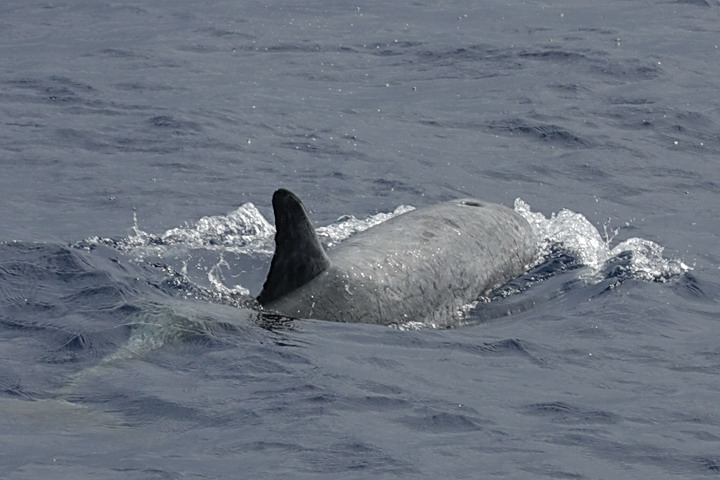
Risso’s dolphin seen offshore of the big island, July 9, 2008. Photo by Annie Douglas. This is only our fifth sighting of Risso’s dolphins in Hawai‘i, and the first in mid-summer (previous sightings were in September 2004, November 2004, April 2008 and May 2008).
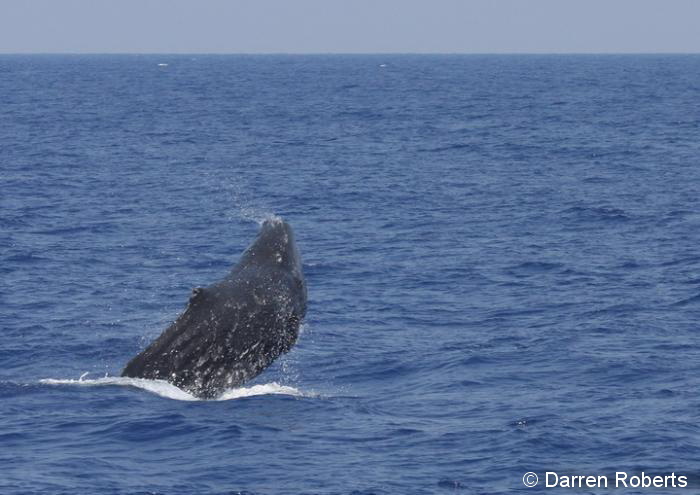
Juvenile sperm whale breaching, July 9, 2008. Photo by Darren Roberts. Since our Hawai‘i work started in 2000 we’ve had 24 sightings of sperm whales in Hawai‘i, 23 sightings off the big island and 1 (a lone individual) off Kaua‘i (in 2003). Group sizes have ranged from 1 to an estimated 16 individuals; our group on July 9th, of 13 individuals, is one of the larger groups documented. As with our sighting on July 6, this group was primarily composed of females and calves, with no adult males present. None of the whales were fluking so we were not able to obtain any identification photos.
July 10 update
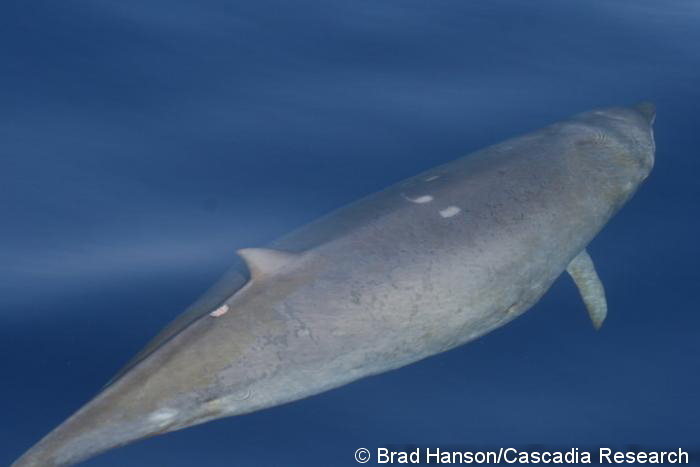
Juvenile Blainville’s beaked whale, July 10, 2008. Photo by Brad Hanson.
Today was a good day. We try to survey in the area of the HARP on a regular basis to ground-truth acoustic detections with visual detections, and when heading to the HARP this morning we spotted a large group of Blainville’s beaked whales (our 12th species for the trip) within a kilometer of the HARP. Despite field work in this area for three weeks in August 2007 and four weeks in April/May 2008, our last encounter where we were able to photo-identify Blainville’s beaked whales was in December 2006, so needless to say we were quite happy to find this group. The group encountered today was the largest we’ve ever documented for this species (11 individuals), and we think we were able to obtain identification photos of all the individuals. The group contained one adult male, 3-4 juveniles, and 6-7 adult females. We were able to deploy three satellite tags (one on the adult male and on two of the adult females), as well as two suction-cup attached time-depth recorder/VHF radio tags.
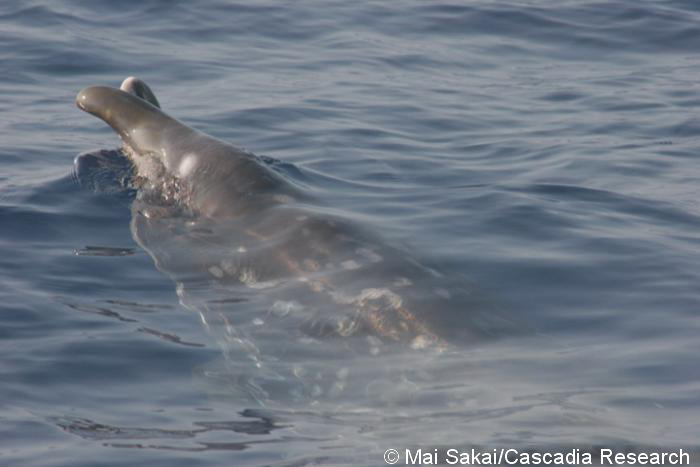
Adult female Blainville’s beaked whale (HIMd025) with a deformed rostrum, July 10, 2008. Photo by Mai Sakai. This individual has been seen multiple times off the island, with sightings in 1991, 1994, 1995, 2002, and 2003 (see the paper by McSweeney et al. published in Marine Mammal Science in 2007 for more information).
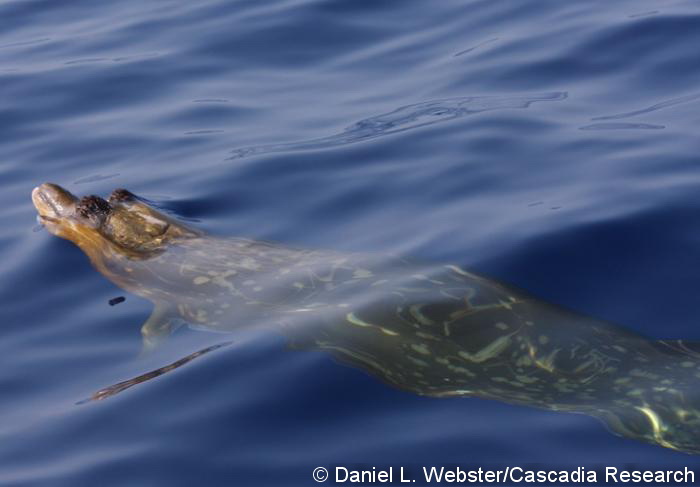
Adult male Blainville’s beaked whale (HIMd020), July 10, 2008. Photo by Daniel Webster. This individual has been documented once previously off Kona, in 2003. Blainville’s beaked whales are strongly sexually dimorphic in skull morphology, with a highly arched lower jaw and teeth that erupt in the middle of the jaw. In Hawai‘i the teeth are often covered in stalked barnacles (see close-up photo below). Male Blainville’s also have extensive linear scars on the head, from fighting with other males.
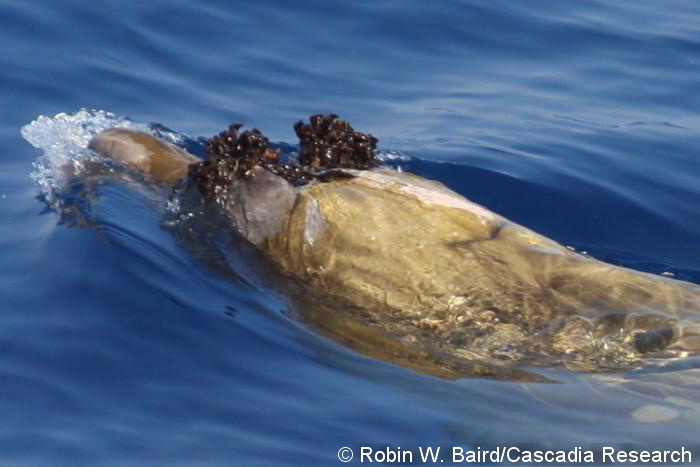
Close-up of the head of an adult male Blainville’s beaked whale (HIMd020), July 10, 2008. Photo by Robin Baird. The teeth that are erupted from the lower jaw are covered in stalked barnacles, and thus are not visible. The brownish coloration covering most of the head are likely diatoms.
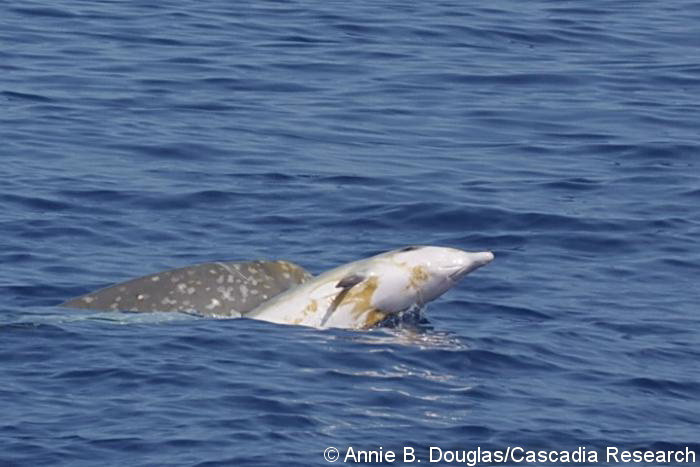
Juvenile Blainville’s beaked whale breaching next to an adult female, July 10, 2008. Photo by Annie Douglas. Note the ventral throat grooves, characteristic of beaked whales. The brownish patches on the belly of this animal are likely diatoms.
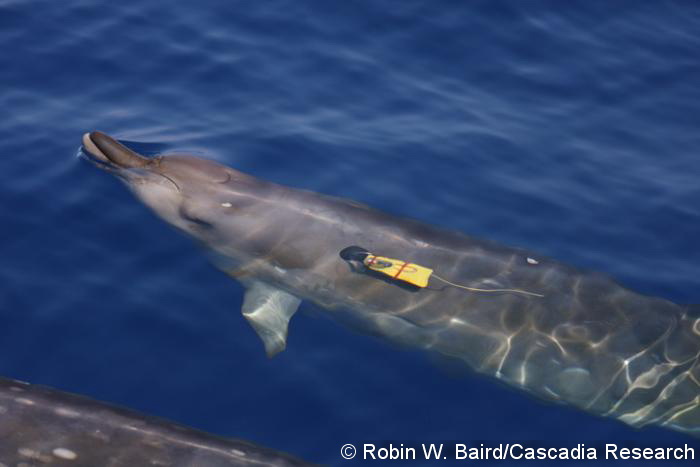
Juvenile Blainville’s beaked whale with suction-cup attached time-depth recorder, July 10, 2008. Photo by Robin Baird. This tag remained attached for approximately 2 hours, during which time the whale made one long dive (45 minutes) to 829 m in depth. Based on the number of white oval scars (caused by cookie-cutter shark bites), we estimate this whale was 1-2 years of age.
July 15 update
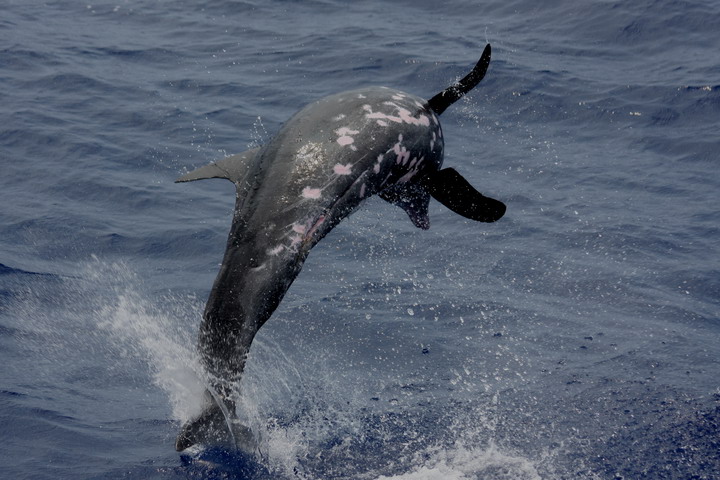
Rough-toothed dolphin leaping, July 12, 2008. Photo by Robin Baird. Note the pink scars on the belly of this dolphin caused by bites from cookie-cutter sharks.
The last five days have been quite productive, with 22 sightings of 8 different species. On July 12 we had our second sighting of a Cuvier’s beaked whale for the trip, an adult male. While we were not able to get close enough to tag, we did get ID photos and this turned to be the same male we saw in the group on July 7. On the 12th we also deployed our 13th satellite tag on a short-finned pilot whale this trip, the 12th off the big island. On July 13 we collected our first squid sample for the trip, that will go to Bill Walker at the National Marine Mammal Laboratory to be identified, as well as be used for stable isotope analyses. We also tagged another pilot whale, the 14th satellite tag deployed on this species this trip.
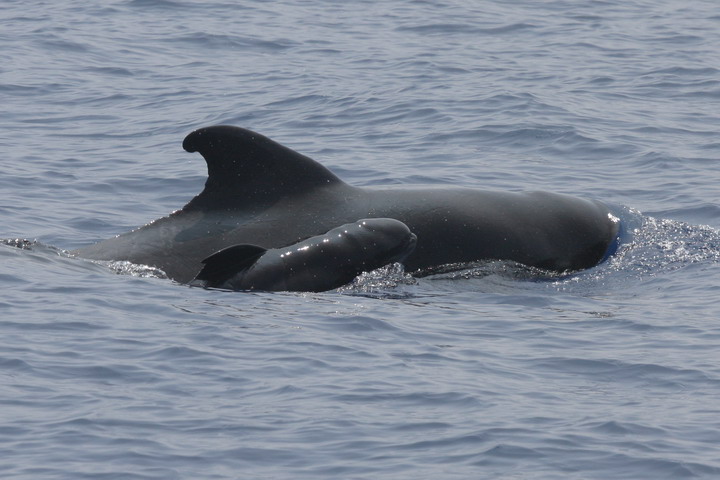
Female and newborn short-finned pilot whale, July 13, 2008. Photo by Daniel Webster. This newborn is probably less than 12 hours old, since the dorsal fin is just starting to straighten.
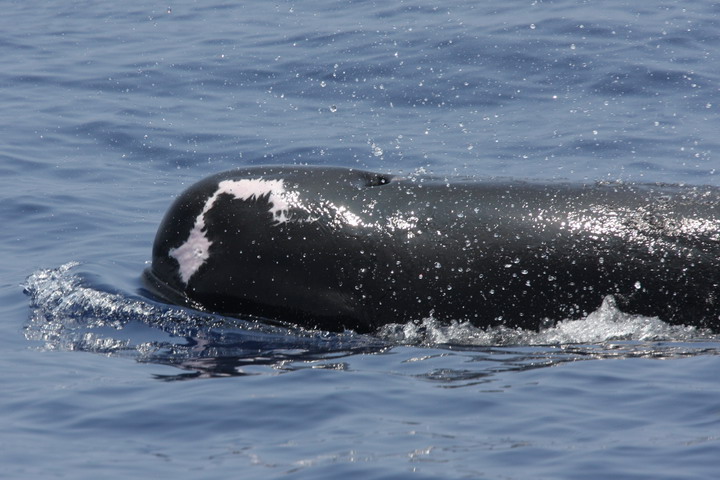
Short-finned pilot whale with healed scar on head, July 13, 2008. Photo by Daniel Webster.
On July 13 we also re-located the group of Blainville’s beaked whales that we had seen on July 10th, with at least 9 whales still together, including the three we had satellite tagged. We carry a receiver on-board the boat that will pick up the radio transmissions from the satellite tags when the animals break the surface (the tags have salt-water switches so they only transmit when above water), and were alerted to the presence of the whales from beeps on the up-link receiver. Unlike VHF radio telemetry the antennae used for the up-link receiver is not strongly directional, but signals are only typically received within a couple of kilometers of the tagged animals, so we were able to spot the animals through binoculars. We re-approached the group and were able to photo-identify most individuals present, and also deployed two additional satellite tags.
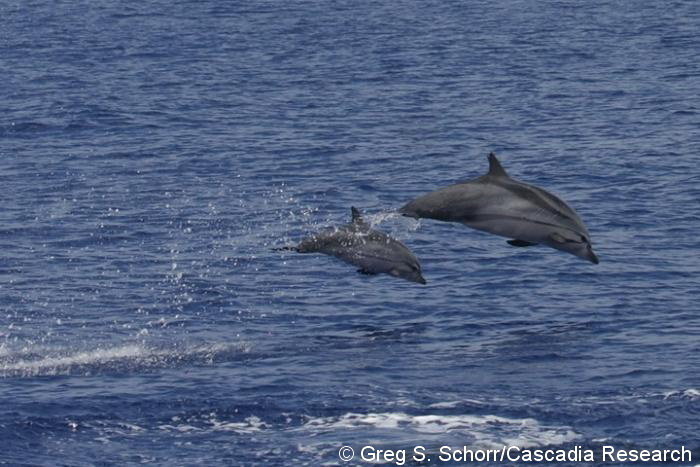
Striped dolphin female and calf, July 15, 2008. Photo by Greg Schorr.
On July 15 we covered 204 kilometers of search effort primarily in Beaufort 1 sea conditions, sighting five different species, including striped dolphins, our second sighting of this species this trip.
July 16 update
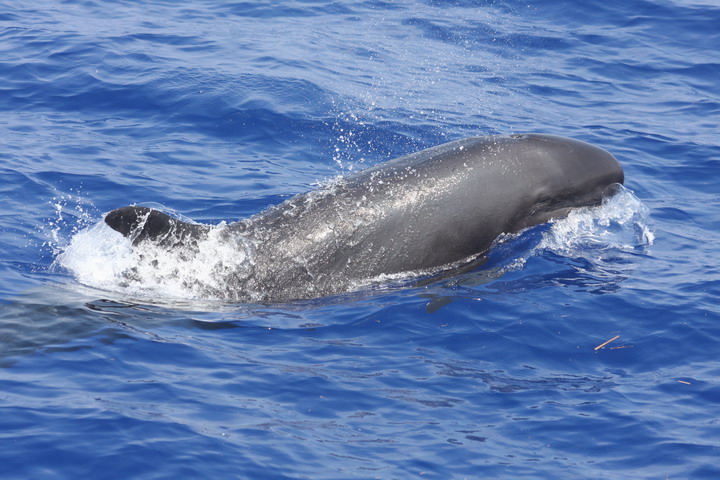
False killer whale off Kona, July 16, 2008. Photo by Robin Baird. On the 16th we encountered our 13th species of odontocete for the trip, a large group of false killer whales. We were able to deploy four satellite tags on individuals in this group, as well as a time-depth recorder (recovered the next day by the NOAA R/V Oscar Elton Sette), collected six biopsy samples for genetics, stable isotope and pollutant anlayses, and photo-identified at least 25 individuals.
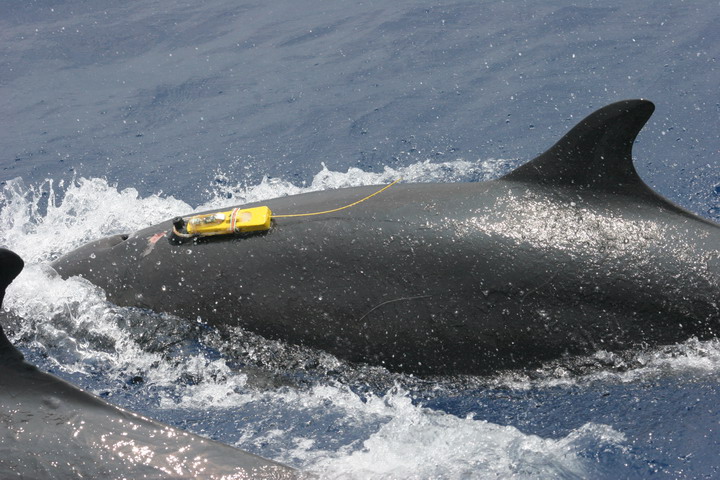
False killer whale with suction-cup attached time-depth recorder, July 16, 2008. Note the wound on the back immediately in front of the tag was not caused by the suction-cup attached tag. Photo by Mai Sakai.
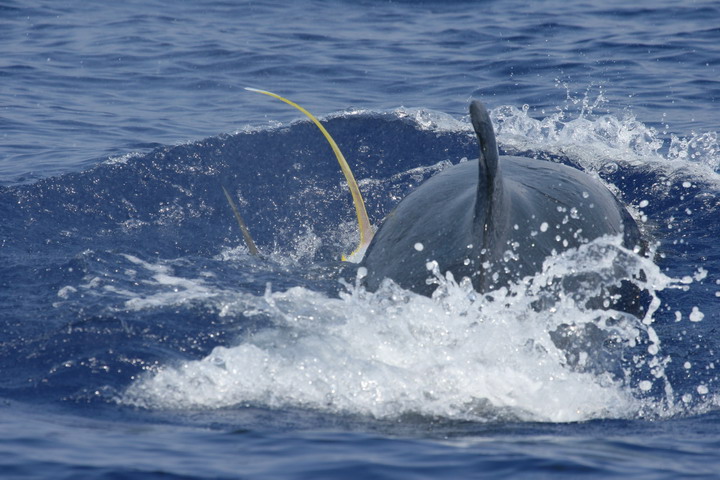
False killer whale with yellow-fin tuna, July 16, 2008. Photo by Brad Hanson.
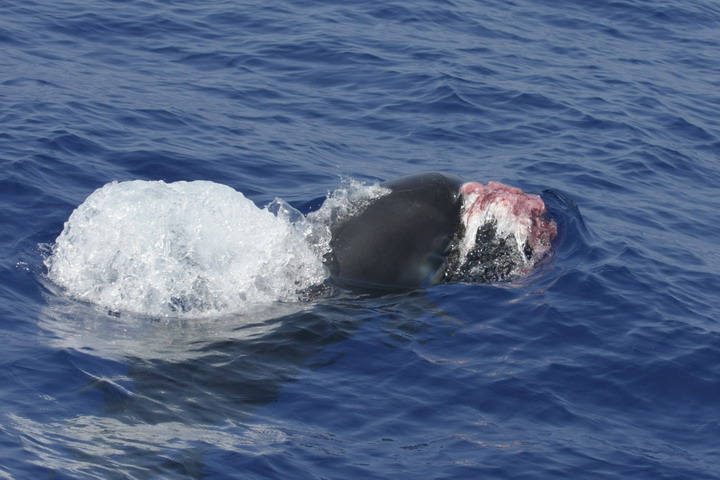
False killer whale surfacing while carrying part of a yellow-fin tuna, July 16, 2008. Photo by Annie Douglas.
An update from the NOAA R/V Oscar Elton Sette
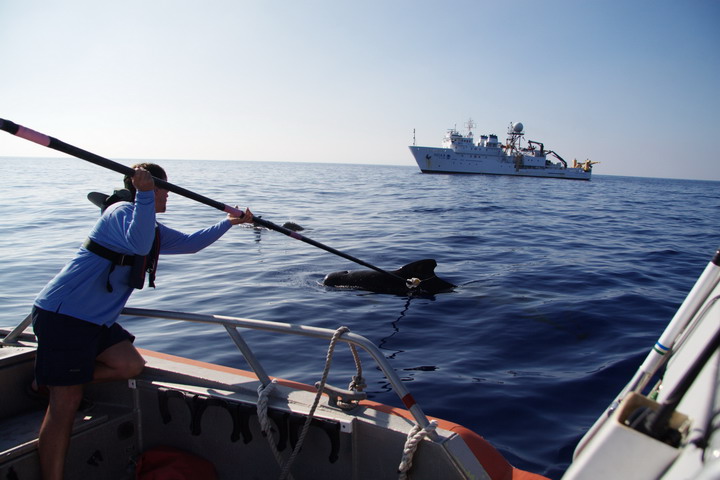
Deploying a suction-cup attached Dtag on a pilot whale, July 15, 2008. Photo by Allan Ligon/Pacific Islands Fisheries Science Center.
During July 15-18 we successfully deployed and recovered three d-tags on pilot whales (two adult males and one adult female) off the Big Island. The tags remained attached for a total of 16 hours. During those four days we had multiple sightings of pilot whales, rough-toothed, bottlenose, spotted, spinner and unidentified small dolphins. We collected 7 biopsy samples from pilot whales and a skin sample from our last tagged pilot whale.
July 21 update
The last five days we’ve had 19 sightings of five different species, with 12 sightings of short-finned pilot whales, three sightings of rough-toothed dolphins (including the largest group we’ve ever documented off this island, an estimated 70 individuals), and 1-2 sightings each of pantropical spotted dolphins, bottlenose dolphins, and Risso’s dolphins (the latter a lone individual in with a group of pilot whales). We’ve had a number of re-sightings of previously satellite-tagged pilot whales (both from this trip and from previous trips), and deployed one additional satellite tag on a pilot whale. With only seven field days left we are now prioritizing future satellite tagging for species other than pilot whales.
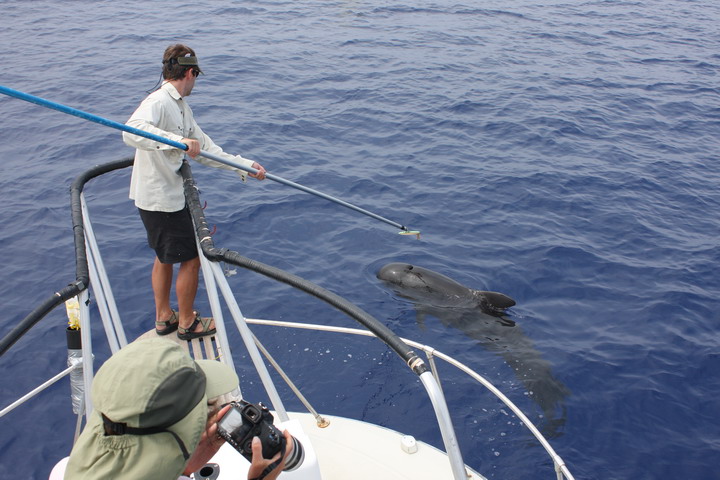
Daniel Webster collecting microbial samples from the exhalations of a juvenile pilot whale, July 20, 2008, for analysis of pathogens by Andrea Bogomolni at Woods Hole Oceanographic Institution. Photo by Robin Baird.
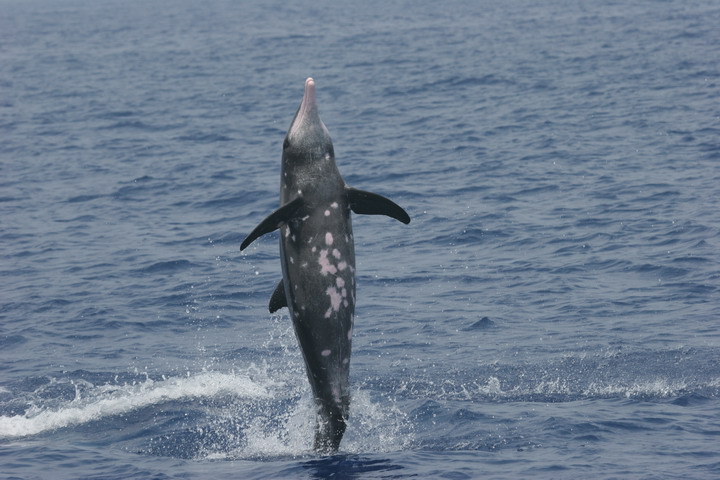
Rough-toothed dolphin leaping, July 21, 2008. Photo by Brandon Southall. Rough-toothed dolphins have been the second-most frequently encountered species of cetacean on this trip, with 23 sightings (out of 99 total to date).
Update from the NOAA R/V Oscar Elton Sette
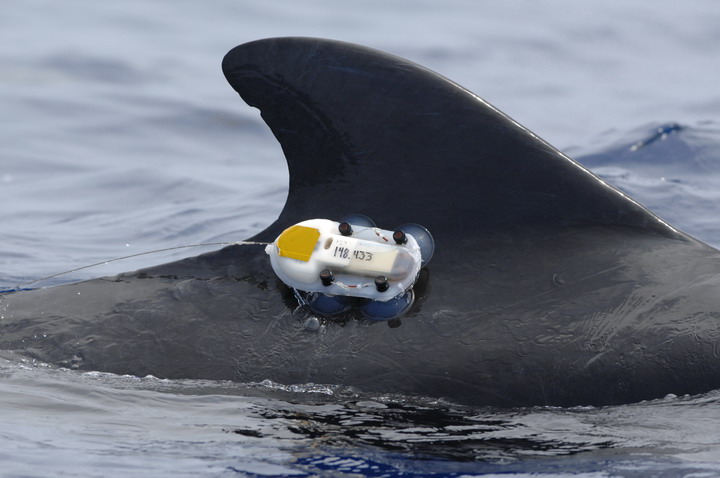
Pilot whale with suction-cup attached Dtag, July 20, 2008. Photo by Ari Friedlaender/Pacific Islands Fisheries Science Center.
On July 20th we deployed our 5th dtag on a pilot whale at 10:57. We were approximately 4 miles west of Kealakekua Bay. The tag was set to come off at approximately 18:00. We had a visual of the tagged animal at approximately 17:15 and then heard the tag for the last time at 18:15. We spent the next 48 hours searching both visually and acoustically from the Sette and from land. We finally found the tag 1 mile offshore floating in the water 23 miles southeast of where we deployed it. Its antenna and a suction cup were missing and, it was covered with teeth marks. Although the casing was damaged the data was still recoverable. That makes five successfully deployed and recovered Dtags.
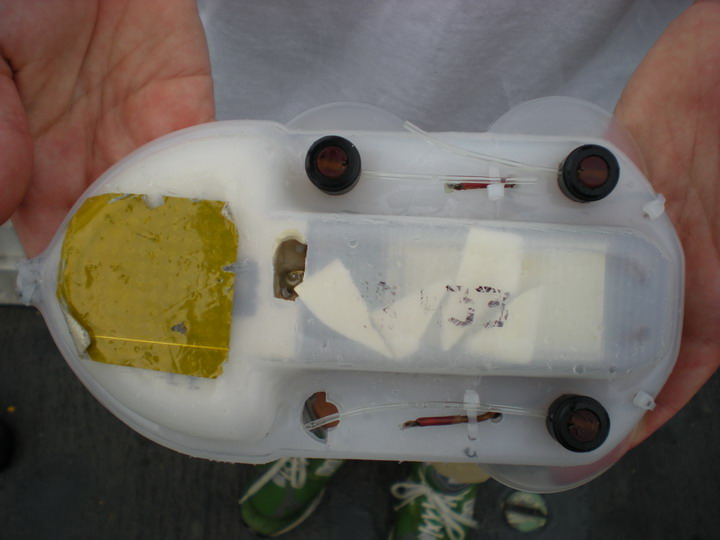
Dtag after it was recovered, missing one suction cup and the antenna, July 22, 2008. Photo by Lesley Thorne/Pacific Islands Fisheries Science Center.
July 25 update
On July 22nd we obtained good identification photos of two dwarf sperm whales, with one matching our catalog (HIKs044), a re-sighting from February 2008. We also collected additional breath samples from two pilot whales for pathogen analysis.
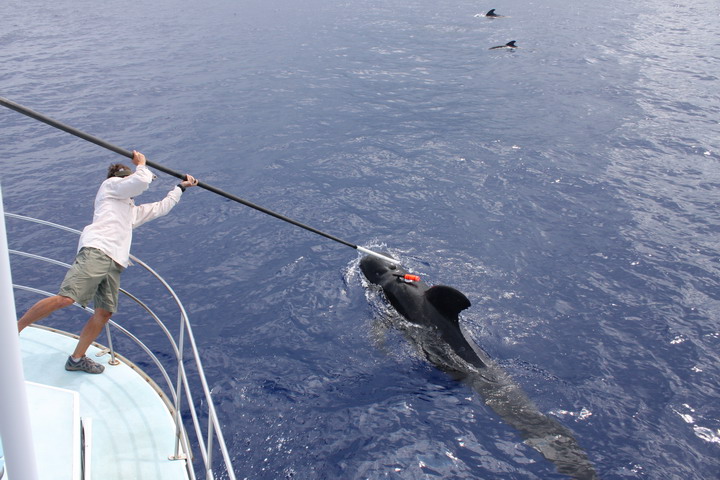
Daniel Webster deploying a suction-cup attached Bioacoustic probe on a short-finned pilot whale, July 25, 2008. Photo by Robin Baird. This tag contains a hydrophone to record sounds around the whale as well as information on depth and underwater movements (using a 2-axis accelerometer). On July 25th we deployed two of these tags, with one remaining attached approximately four hours and the other remaining attached through the night. Both tags were recovered by researchers on the NOAA R/V Oscar Elton Sette.
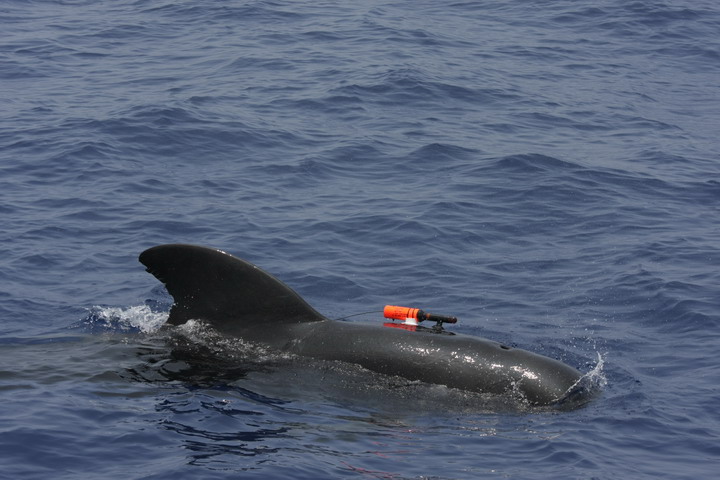
Adult male short-finned pilot whale with suction-cup attached Bioacoustic probe, July 25, 2008. Photo by Daniel Webster.
July 26 update
For the last 10 days we’ve been monitoring the movements of the false killer whales that we satellite-tagged on July 16. Each day we’ve been receiving multiple locations from the tagged whales via the ARGOS satellite system. Over that period the whales have remained associated with the island, but have spent their time north of our study area or off the east side of the island. This morning we were excited to obtain ARGOS locations of tagged whales that were in the northern part of our study area, with a trend over the previous 12 hours of southward movement. Within an hour of leaving the harbor we encountered a dispersed group of approximately 20 individuals, moving south along the coast. We were able to photo-identify most of the individuals present, and also deployed two additional satellite tags on individuals in the group, to increase the likelihood of tracking multiple sub-groups when this group splits.
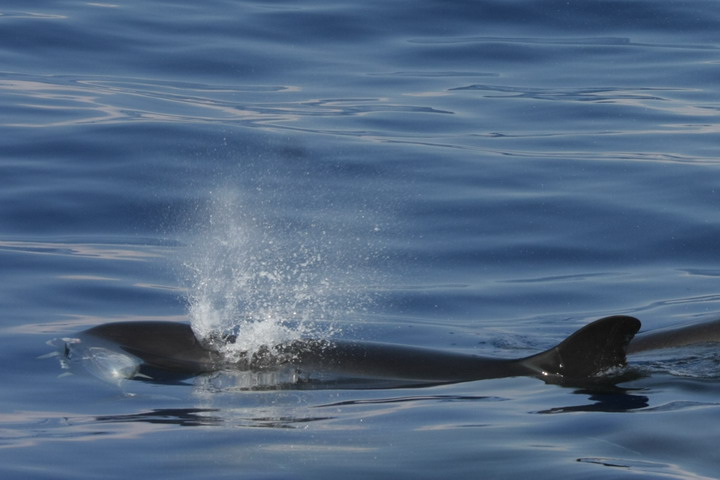
False killer whale with tuna, July 26, 2008. Photo by Annie Douglas.
July 27 update
Today was our last day on the water. We re-located the group of false killer whales from yesterday and obtained identification photos of perhaps 30 individuals, as well as IDs of a number of bottlenose dolphins. All together we spent 31 days on the water, covering approximately 3,600 km of survey trackline. We had 109 sightings of 13 species of cetaceans, including 42 sightings of short-finned pilot whales, 23 sightings of rough-toothed dolphins, 7 sightings each of pantropical spotted dolphins and bottlenose dolphins, 5 sightings of dwarf sperm whales, 4 sightings each of melon-headed whales and spinner dolphins, 3 sightings of false killer whales (2 as a result of re-locating the original satellite tagged group), 2 sightings each of sperm whales, Cuvier’s beaked whales, Blainville’s beaked whales, Risso’s dolphins, and striped dolphins, and 4 sightings of unidentified small odontocetes (most likely dwarf sperm whales or rough-toothed dolphins).
In terms of being able to track movements of individuals in relation to the RIMPAC naval exercise, we were able to deploy medium-term satellite tags on four species of odontocetes, including 16 short-finned pilot whales, 6 false killer whales, 5 Blainville’s beaked whales, and 5 melon-headed whales. We are continuing to receive multiple locations each day from the majority of these tagged individuals. As well as the satellite tag deployments, we deployed suction-cup attached data recording tags on two Blainville’s beaked whales, one false killer whale, and three short-finned pilot whales. For better or for worse, we took >48,000 photographs (156 gigs!).
September 4 update
More than five weeks after we left the field we are still receiving locations from eight of the satellite tagged whales. Seven of the tags are transmitting daily, while one was programmed to switch to every second day after the first 43 days on the whale. The tags are still transmitting on three of the Blainville’s beaked whales (day 56 for two and day 52 for the third), two of the false killer whales (day 50 for one and day 40 for the other), and three of the short-finned pilot whales (day 62, day 53, and day 47). Prior to this project the longest we’d had a tag transmit for was 23 days for a Blainville’s beaked whale (from November 2006), 32 days for a false killer whale (from August 2007), and 52 days for a pilot whale (from May 2008), so these longer-term tracks are providing information on movements of these individuals that we’ve never been able to collect before. We hope they will continue to transmit for many more weeks, although some of them are getting close to reaching the theoretical end of their battery life. The satellite locations have allowed Dan McSweeney to re-locate several of the groups to photo-identify individuals, both to examine associations and to assess how the tag sites are healing. Although the data are still coming in from these whales, the analysis process has begun on tags that have stopped transmitting.
All photos on this page taken under NMFS Scientific Research Permits (Nos. 731-1774 and 774-1714). All photos are copyrighted and should not be used without permission.
Return to the Cascadia Research Hawai‘i web page